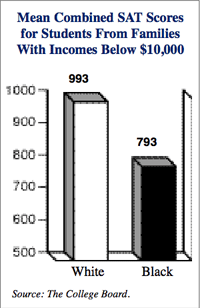Income-Based Affirmative Action Will Do Almost Nothing to Produce Greater Racial Diversity in Public Schools or in Colleges and Universities In efforts to bring about greater racial diversity in our nation’s public schools, colleges, and universities, income-based affirmative action is not a useful substitute for race-sensitive admissions. This past June, the U.S. Supreme Court in a 5-4 vote rejected public school assignment plans in the cities of Seattle and Louisville that were based on students’ race. (For more on this decision, see page 12 of this issue of JBHE.) As a consequence of this decision, it has been suggested by both proponents and opponents of race-based affirmative action that there is a viable alternative that could achieve similar results. According to this theory, if school assignments were to be based on family income levels, a significant amount of racial diversity would be achieved because of the simple fact that blacks make up a disproportionately large segment of the low-income population. Our view is that this theory is mere wish-ful thinking. Socioeconomic affirmative action admissions plans, whether they be in K-12 education or at the college level, are just short of a useless substitute for race-sensitive plans if one’s goal is to achieve a significant level of racial diversity. A look at the results of standardized tests used for college admission shows that, under a straight nonracial but socio-economic affirmative action admission plan, almost all places at America’s highest-ranked universities would be taken up by nonblacks.
Therefore, if college admissions officials were to shift affirmative action or preferential admissions programs to a system based on socioeconomic status and give preference to students from families from these lower-income brackets without regard to race, it appears that white students — based on their significantly higher test scores at all income levels — would continue to hold a huge admission advantage over black students. Also, a new socioeconomic basis for preferential admissions would greatly favor whites for the simple reason that in the United States the white poor outnumber the black poor by more than three to one. Among those in the prime college-going years of 18 to 24, there are 3.5 million poor whites in this country and 1.1 million blacks from families who live below the government’s official poverty line. Although blacks are disproportionately represented in the lower-income brackets, there are still far more whites from families with low incomes than there are low-income blacks. In 2006, 38 percent of all black SAT test takers were from families with incomes below $40,000 compared to only 11.5 percent of all white test takers. However, in sheer numbers white test takers in these low-income categories outnumber blacks by a margin of roughly two to one. Remember, too, these low-income whites are likely to have combined SAT scores that on average are 180 to 200 points higher than blacks from comparable low-income families. Asian Americans would undoubtedly be the major beneficiaries of affirmative action programs based on socioeconomic status. Asians’ average scores on standardized tests are even higher than the average scores for whites. There are many recent immigrant families from Korea, Thailand, Vietnam, and other Asian nations that have not achieved middle-class status but whose children perform extremely well in school. High-achieving Asian students from these lower-income families would garner many places at the nation’s most prestigious universities which previously had gone to blacks under race-sensitive admissions.
|
|




 According to statistics supplied to JBHE by The College Board, college-bound white students from families with low incomes score considerably higher than college-bound blacks from families with low incomes. For example, for white students from families with incomes below $10,000, the median SAT score in 2006 was 488 on the critical reading portion of the test and 505 on the math portion. For blacks from families with incomes below $10,000, the median SAT score was 398 on the verbal portion and 395 on the math. A similar 90 to 110 point gap occurs at other low-income levels such as those for families with incomes between $10,000 and $20,000 and for families with incomes ranging from $20,000 to $30,000. In fact, the SAT score gap between blacks and whites in the lower-income brackets mirrors the gap for the test-taking population as a whole.
According to statistics supplied to JBHE by The College Board, college-bound white students from families with low incomes score considerably higher than college-bound blacks from families with low incomes. For example, for white students from families with incomes below $10,000, the median SAT score in 2006 was 488 on the critical reading portion of the test and 505 on the math portion. For blacks from families with incomes below $10,000, the median SAT score was 398 on the verbal portion and 395 on the math. A similar 90 to 110 point gap occurs at other low-income levels such as those for families with incomes between $10,000 and $20,000 and for families with incomes ranging from $20,000 to $30,000. In fact, the SAT score gap between blacks and whites in the lower-income brackets mirrors the gap for the test-taking population as a whole.